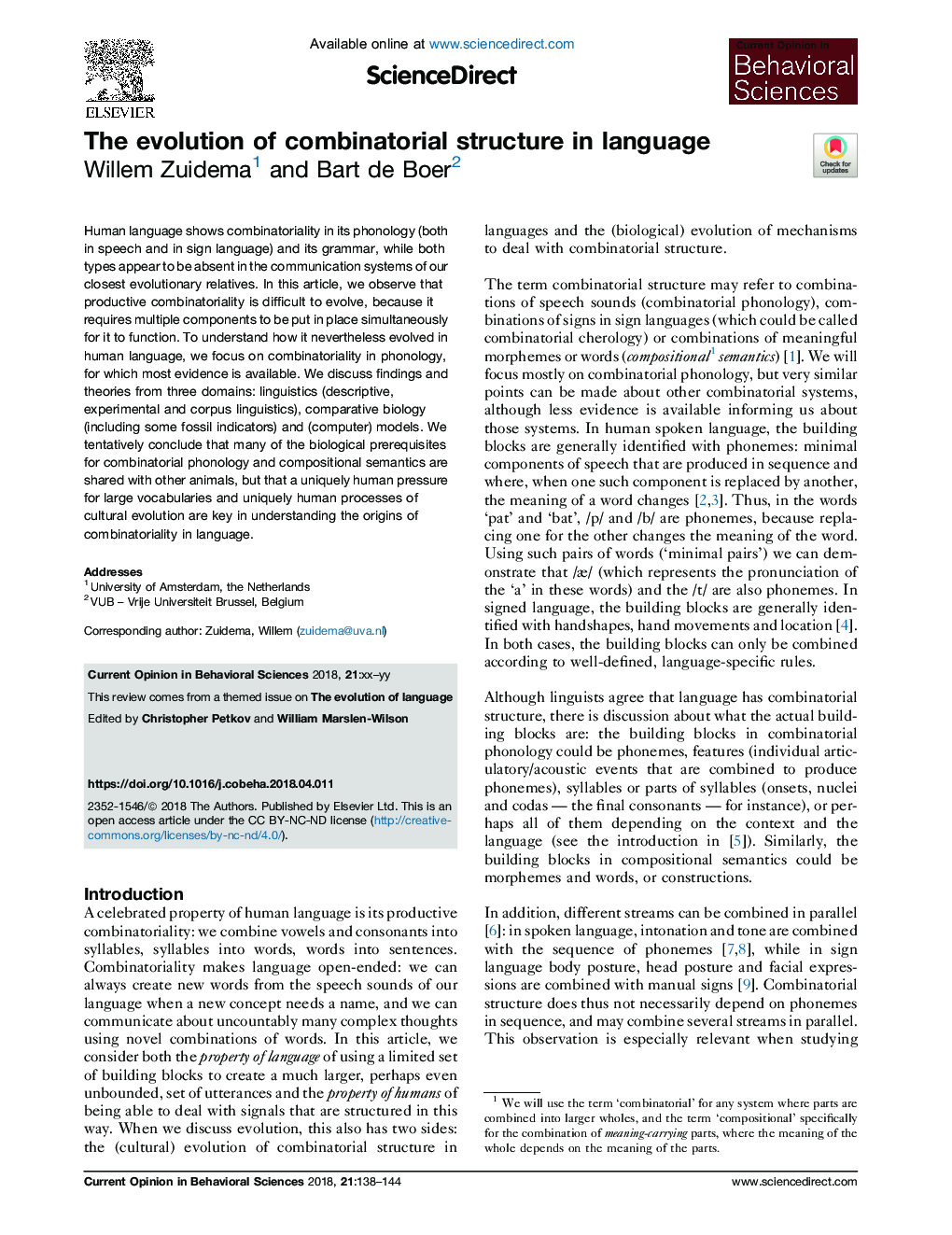| کد مقاله | کد نشریه | سال انتشار | مقاله انگلیسی | نسخه تمام متن |
|---|---|---|---|---|
| 8838117 | 1613069 | 2018 | 7 صفحه PDF | دانلود رایگان |
عنوان انگلیسی مقاله ISI
The evolution of combinatorial structure in language
ترجمه فارسی عنوان
تکامل ساختار ترکیبی در زبان
دانلود مقاله + سفارش ترجمه
دانلود مقاله ISI انگلیسی
رایگان برای ایرانیان
ترجمه چکیده
زبان انسانی ترکیبی از ویژگی های زبان شناسی آن (در زبان و زبان اشاره) و دستور زبان آن را نشان می دهد، در حالی که هر دو نوع در سیستم های ارتباطی نزدیک ترین بستگان تکاملی ما وجود دارند. در این مقاله، ما مشاهده می کنیم که ترکیبی از مولکولی تولیدی دشوار است، زیرا به چندین مولفه نیاز دارد که به طور همزمان برای آن عمل کند. برای درک چگونگی آن در زبان انسانی تکامل یافته، ما تمرکز داریم بر ترکیبی بودن واژگان، که بیشتر شواهد موجود است. ما در مورد یافته ها و نظریه ها از سه حوزه: زبان شناسی (توصیفی، تجربی و زبانشناسی)، زیست شناسی مقایسه (از جمله برخی از شاخص های فسیلی) و (مدل های کامپیوتری) بحث می کنیم. ما به طور خلاصه نتیجه می گیریم که بسیاری از پیش نیازهای بیولوژیکی برای واژگان ترکیبی و معنایی ترکیبات با حیوانات دیگر به اشتراک گذاشته شده اند، اما فشار انحصاری انسان برای واژگان بزرگ و فرایندهای منحصر به فرد انسانی فرهنگی در درک مبانی ترکیبیات در زبان، کلیدی است.
موضوعات مرتبط
علوم زیستی و بیوفناوری
علم عصب شناسی
علوم اعصاب رفتاری
چکیده انگلیسی
Human language shows combinatoriality in its phonology (both in speech and in sign language) and its grammar, while both types appear to be absent in the communication systems of our closest evolutionary relatives. In this article, we observe that productive combinatoriality is difficult to evolve, because it requires multiple components to be put in place simultaneously for it to function. To understand how it nevertheless evolved in human language, we focus on combinatoriality in phonology, for which most evidence is available. We discuss findings and theories from three domains: linguistics (descriptive, experimental and corpus linguistics), comparative biology (including some fossil indicators) and (computer) models. We tentatively conclude that many of the biological prerequisites for combinatorial phonology and compositional semantics are shared with other animals, but that a uniquely human pressure for large vocabularies and uniquely human processes of cultural evolution are key in understanding the origins of combinatoriality in language.
ناشر
Database: Elsevier - ScienceDirect (ساینس دایرکت)
Journal: Current Opinion in Behavioral Sciences - Volume 21, June 2018, Pages 138-144
Journal: Current Opinion in Behavioral Sciences - Volume 21, June 2018, Pages 138-144
نویسندگان
Willem Zuidema, Bart de Boer,
